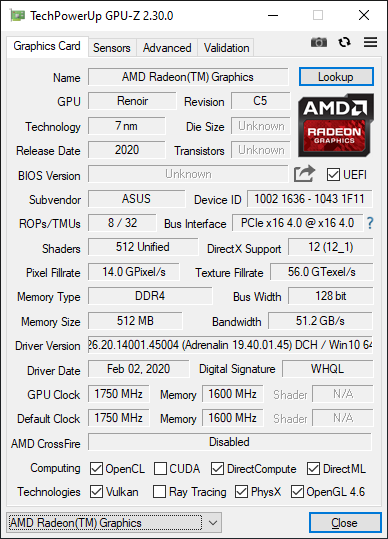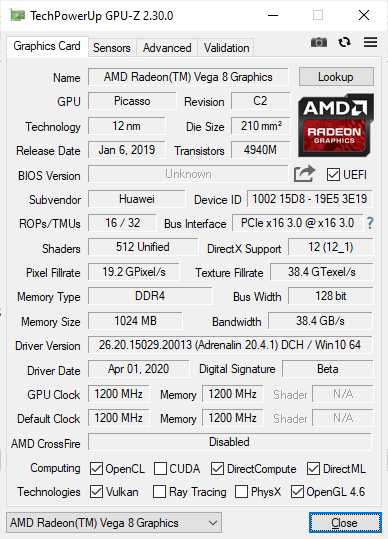AMD’s Mobile Revival: Redefining the Notebook Business with the Ryzen 9 4900HS (A Review)
by Dr. Ian Cutress on April 9, 2020 9:00 AM ESTTesting the Ryzen 9 4900HS Integrated Graphics
Under the hood of the Ryzen 9 4900HS, aside from the eight Zen 2 cores, is an enhanced Vega 8 graphics solution. For this generation of mobile processors, AMD is keeping the top number of compute units to 8, whereas in the previous generation it went up to Vega 11. Just by the name, one would assume that AMD has lowered the performance of the integrated graphics. This is not the case.
For the new Ryzen Mobile 4000 processors, the Vega graphics here are enhanced in three main ways over the previous generation. First is that it is built on the 7nm process node, and AMD put a lot of effort into physical design, allowing for a more optimized version that has a wider voltage/frequency window compared to the previous generation. Secondly, and somewhat connected, is the frequency: the new processors top out at 1750 MHz, rather than 1400 MHz, which would naturally give a simple 25 % boost with all other things being equal. Third on the list is memory, as the new platform supports up to DDR4-3200, rather than DDR4-2400, providing an immediate bandwidth boost which is what integrated graphics loves. There’s also the nature of the CPU cores themselves, having larger L3 caches, which often improves integrated graphics workloads that interact a lot with the CPU.
Normally, with the ASUS Zephryus G14, the switching between the integrated graphics and the discrete graphics should be automatic. There is a setting in the NVIDIA Control Panel to let the system auto-switch between integrated and discrete, and we would expect the system to be on the IGP when off the wall power, but on the discrete card when gaming (note, we had issues in our battery life test where the discrete card was on, but ASUS couldn’t reproduce the issue). In order to force the integrated graphics for our testing, because the NVIDIA Control Panel didn’t seem to catch all of our tests to force them onto the integrated graphics, we went into the device manager and actually disabled the NVIDIA graphics.
This left us with AMD’s best integrated graphics in its Ryzen Mobile 4000 series: 1750 MHz of enhanced Vega 8 running at DDR4-3200.

Renoir with Vega 8 – updated to 20.4 after this screenshot was taken
Our comparison point here is actually a fairly tricky one to set up. Unfortunately we do not have a Ryzen 7 3750H from the previous generation for comparison, but we do have an Honor Magicbook 14, which has a Ryzen 5 3500U.
This is a 15 W processor, running at 1200 MHz and DDR4-2400, which again makes the comparison a little tricky, but it is better than comparing it to the Intel HD630 graphics in the Razer Blade.
We also re-ran the benchmarks on the latest drivers with AMD's 65 Desktop APUs, the Ryzen 5 3400G (with Vega11) and the Ryzen 3 3200G (with Vega 8). These are running at DDR4-2933, the AMD maximum officially supported by these APUs (which means anything above this is overclocking).


This is a pretty substantial difference, no joke.



Hopefully we will get more variants of the Ryzen integrated graphics to test, along with an Ice Lake system.











267 Comments
View All Comments
guachi - Thursday, April 9, 2020 - link
I was looking at the very Razer you had in this review. Ended up preordering the Asus.So I thank you for the review and the comparison choice.
Mat3 - Thursday, April 9, 2020 - link
I know that's not a real die shot, but even so, that's the worst "fake" die shot I've ever seen.StevoLincolnite - Thursday, April 9, 2020 - link
I have a Ryzen 2700u notebook which I will happily toss out the window for this.ballsystemlord - Thursday, April 9, 2020 - link
Spelling and grammar errors:"If Intel has a lower frequency, fewer cores, and a lower frequency, all for the same power envelope as AMD, then it looks like a slam dunk for AMD."
Double "lower frequency":
"If Intel has a fewer cores and a lower frequency, all for the same power envelope as AMD, then it looks like a slam dunk for AMD."
"When the system does the battery life done right, it's crazy good."
Badly worded:
"When the system balances performance and battery life, it's crazy good."
mkozakewich - Thursday, April 9, 2020 - link
On these kinds of systems, battery life can tank when something goes wrong. I wonder if there was also a reason that the Intel system was showing such poor battery life.When AnandTech reviewed the Surface Book, I remember them giving it a really low battery life score. It turns out there's some kind of problem with the GPU connection, and the device will get twice the life if you disconnect and reconnect the tablet portion multiple times. I actually get 12 hours on my 2017 Surface Book 2. The system can run on 4 W. So, finally! I've never even considered an AMD system, because they would run closer to 8 or 12 watts, and that meant they'd either have a massive and heavy battery, or they'd only last a few hours.
But the caveat: As you see here, and with the Surface Book, that efficiency can go out the window if one thing goes wrong.
zodiacfml - Thursday, April 9, 2020 - link
Thanks for the Anandtech quality review. I hope we see cheaper 8 core laptops without discrete graphics. Seeing the performance of the iGPU on two memory speeds, hope to see AMD with integrated memory in its future products like what they did in the PS5/Series X, great for mobile and compact desktop PCsplonk420 - Friday, April 10, 2020 - link
thanks for the latency numbers! huuuuge help for emulation fans (or at least PS3 emulation fans)!deil - Friday, April 10, 2020 - link
a bit high idle speed, but that response times is what we want most for "snappy laptop" which feels fast. I really want one now...Haawser - Friday, April 10, 2020 - link
Hey Ian, could you do some iGPU game tests with a 720p render target, but running full screen with RIS ? I'd be interested to see if you can get much higher frame rates but without a massive loss of subjective IQ ? Cheers.Fulljack - Friday, April 10, 2020 - link
I'm interested with AMD 25x20 initiative. Could you please make an update for it? Last time you did was two years ago back in 2018. It would be an interesting piece of article to show how much AMD has grown. Thanks!https://www.anandtech.com/show/13326/amd-updates-i...